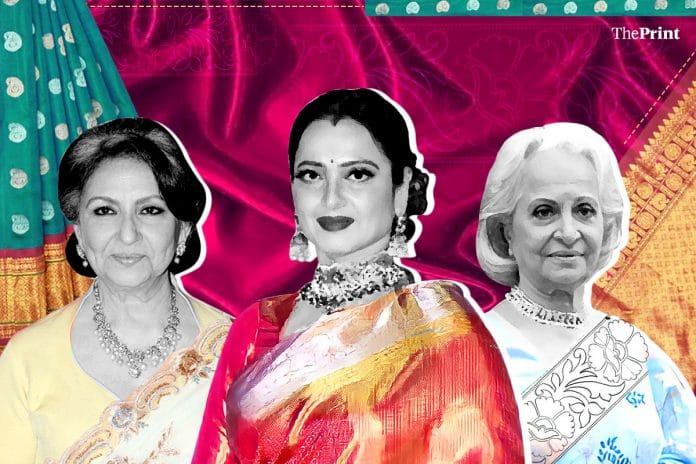Around the 1870s, in Lahore, which was the cultural capital of British India, Ushnak Mal would load his horse-pulled cart or tonga with the finest of silk pieces with zari and brocade work, and set out to visit various seths, sahukars, and royal families, selling them these fabrics collected from textile hubs across India.
The women would use these fabrics to style shararas (bell-bottom trousers worn with short tunics), ghararas (loose trousers worn with peplum tops) and lehengas. These women were very particular about matching chunnis and odhnis — the most dressy and colourful part of the ensemble.
As is visible from the archival images and photographs of the mid-1800s India — this era was akin to the Victorian times when tremendous attention was paid to maintain the richness and splendour of personal grooming. In fact, a person’s place and standing in society was very much judged by their sense of clothing, footwear, and accessories. So vendors such as Ushnak Mal, who offered curated and exclusive selections, earned good profits.
Soon, Ushnak Mal’s son Mool Chand joined him in the trade, and together, they opened a shop in Lahore’s Anarkali Bazaar. It was called Ushnak Mal Mool Chand. They also built a large haveli, which is said to have had 101 rooms.
From Mool Chand’s son Roop Lal to his son Rickey Ram — each generation took Ushnak Mal Mool Chand’s trade forward by enlarging the palette and adopting new fashion trends. By the early 1900s, the shop had become very popular in Lahore. “The shop became a place for festival and trousseau-shopping for all kinds of saris and fabrics. Various prominent personalities of the time, including the Viceroys and their wives, would visit the shop whenever there were high-level ceremonial functions or weddings in the family. My great-grandfather was most impressed with Jawaharlal Nehru, and so, when the Swadeshi Movement started, our family decided to sell only Indian clothes. It was a big thing for a prominent shop to make an announcement like that during British rule,” says Rajeev Tandon, the current owner of Ushnak Mal Mool Chand.
Also read: ‘Pista barfi pioneer’, Kanwarji was Chandni Chowk’s OG snacking site. Now selfie spot too
The jolt of 1947
The shop owners suffered a big jolt in 1947. Rickey Ram was wise enough to pay heed to the early warnings about Partition. Almost from the time the rumours started, Ram transferred a lot of valuable goods and money to Delhi. He and his family fled to Delhi on a train and set up their residence at Western Extension Area (WEA). Ram surveyed and studied the purchase trends and realised that there would be no better place for a shop than at Karol Bagh market for his new innings.
The locality was already a popular market for wedding and festival-related high-end shopping. “In [the] ’50s and ’60s, the popular trends were dabka work, salma sitaara embroidery and saris with real gold and silver zari work. Even today, families bring back the saris they purchased from us 60 to 70 years ago, and they look just the same. The weavers of Varanasi, Amethi, Farrukhabad, Bareilly, and Lucknow produced such fine quality saris that they lasted longer than a house does!” says Rajeev about the textile work produced in India.
“My grandfather Ricky Ram ji was a friend of B.R Chopra, and my father Ravi Tandon was a friend of Yash Chopra. So a lot of our materials and sarees were featured in films such as Kabhi Kabhi (1976) and Chandni (1989), which had a big female cast in a rich setting. Thereafter, a lot of actors, including Waheeda Rehman, Nutan, Sharmila Tagore, Rekha, Deepti Naval, patronised our collections. We worked very closely with director Meera Nair on her film Kama Sutra (1996) and the costume department of Parineeta (2005),” says Rajeev.
In an era dominated by audio-visuals, where politicians must make an impression on social media and look different each day, Ushnak Mal Mool Chand designers say they have been entrusted with creating campaign wardrobes for many female politicians. The aim is to create an Instagram-worthy repertoire that is eye-catching but easy to wear. Reluctant to reveal names, Rajeev Tandon says: “We are the backroom team for the lead cast and prefer to remain so. Let’s just say our brand may not be visible, but our product is everyday visible on the big and small screen.”
This article is a part of a series called BusinessHistories exploring iconic businesses in India that have endured tough times and changing markets. Read all articles here.






